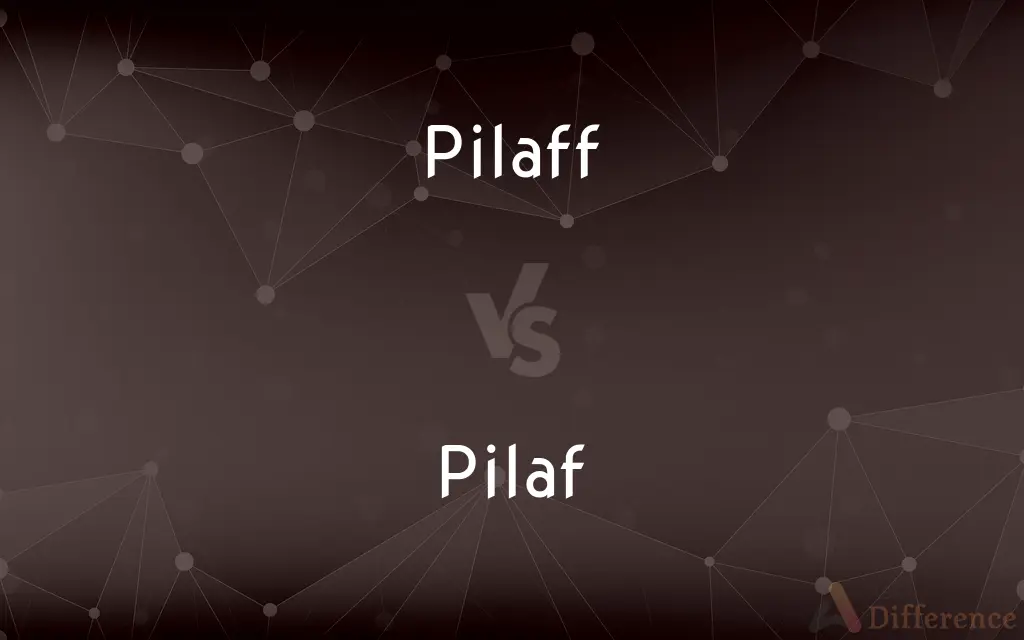Pilaff vs. Pilaf — What's the Difference?
By Urooj Arif & Maham Liaqat — Updated on March 30, 2024
Pilaff and pilaf refer to the same dish: a seasoned rice cooked in broth, often with added meats, vegetables, or dried fruits, with "pilaf" being the more commonly used spelling.

Difference Between Pilaff and Pilaf
Table of Contents
ADVERTISEMENT
Key Differences
Pilaff and pilaf are two variations of the same word, referring to a Middle Eastern and Central Asian dish that has gained popularity worldwide. Both terms describe a culinary preparation where rice is cooked in a seasoned broth, which can be enhanced with ingredients like meats, vegetables, nuts, and dried fruits. The dish is celebrated for its aromatic flavors and the distinct, fluffy texture of the rice grains.
The difference between "pilaff" and "pilaf" lies primarily in the spelling and regional language influences. "Pilaf" is the more widely accepted and used term in English, derived from the Turkish word "pilav." On the other hand, "pilaff" is a less common variant that may appear in certain English-speaking regions or in older texts. Despite the spelling differences, there is no distinction in the dish itself when prepared under either name.
Pilaf is known for its versatility, serving as a staple side dish or a main course, depending on the added ingredients. Its preparation techniques vary across cultures, with some traditions emphasizing the browning of the rice in oil before adding the broth, while others might include specific spices and herbs to achieve unique regional flavors. Meanwhile, pilaff, as an alternate spelling, encompasses the same range of recipes and methods, reflecting the dish's adaptation and integration into various culinary traditions.
The method of cooking pilaf (or pilaff) aims to ensure that each grain of rice remains separate and not sticky, a characteristic achieved through the correct ratio of liquid to rice and sometimes the use of long-grain varieties like basmati. This technique contrasts with other rice dishes that might prioritize creaminess or stickiness, highlighting the unique culinary skill and tradition behind pilaf.
In summary, whether referred to as pilaff or pilaf, the dish represents a rich cultural tradition of rice cooking, celebrated for its aromatic flavors and the skillful technique required to achieve the perfect texture. The choice between spellings does not signify a difference in the dish but rather reflects linguistic preferences.
ADVERTISEMENT
Comparison Chart
Definition
A seasoned rice dish cooked in broth.
A seasoned rice dish cooked in broth.
Spelling Variation
Less common spelling used in certain regions or older texts.
More commonly used spelling in English.
Linguistic Origin
Variant influenced by regional language or historical use.
Derived from the Turkish "pilav."
Ingredients
Can include meats, vegetables, nuts, dried fruits.
Can include meats, vegetables, nuts, dried fruits.
Preparation Method
Cooked in broth, aiming for fluffy and separate grains.
Cooked in broth, aiming for fluffy and separate grains.
Cultural Adaptation
Reflects adaptation to various culinary traditions.
Reflects adaptation to various culinary traditions.
Compare with Definitions
Pilaff
Reflects the dish's broad cultural integration and adaptation.
The cookbook featured pilaff recipes from various countries, showcasing its versatility.
Pilaf
A seasoned rice dish, cooked in broth, often with added ingredients.
He mastered the art of making chicken pilaf, much to his family's delight.
Pilaff
A variant spelling of pilaf, denoting a seasoned rice dish cooked in broth.
For dinner, she prepared a savory pilaff with lamb and apricots.
Pilaf
Requires skill to maintain the rice's fluffy and non-sticky texture.
Her pilaf always came out perfectly fluffy, thanks to her meticulous technique.
Pilaff
Can be enriched with a variety of ingredients for added flavor.
Their family recipe for pilaff includes a mix of roasted nuts and raisins.
Pilaf
Emphasizes the use of specific spices and herbs for unique flavors.
The key to an aromatic pilaf is the blend of spices used during cooking.
Pilaff
Serves as both a comforting side dish and a nutritious main course.
The vegetable pilaff was hearty enough to be the centerpiece of the meal.
Pilaf
Adaptable to various dietary preferences and ingredients.
The vegetarian pilaf was a hit at the potluck, appealing to all guests.
Pilaff
Aims for a distinctive texture where rice grains remain separate.
Achieving the perfect pilaff requires precise liquid measurement and timing.
Pilaf
Integrates into numerous cultural cuisines with regional variations.
While traveling, they enjoyed pilaf variations, each reflecting local tastes.
Pilaff
A steamed rice dish often with meat, shellfish, or vegetables in a seasoned broth.
Pilaf
Pilaf (US spelling), or pilau (UK spelling) is a rice dish, or in some regions, a wheat dish, whose recipe usually involves cooking in stock or broth, adding spices, and other ingredients such as vegetables or meat, and employing some technique for achieving cooked grains that do not adhere.At the time of the Abbasid Caliphate, such methods of cooking rice at first spread through a vast territory from India to Spain, and eventually to a wider world. The Spanish paella, and the South Asian pilau or pulao, and biryani, evolved from such dishes.
Pilaff
Alternative spelling of pilaf
Pilaf
A steamed rice dish often with meat, shellfish, or vegetables in a seasoned broth.
Pilaff
Rice cooked in well-seasoned broth with onions or celery and usually poultry or game or shellfish and sometimes tomatoes
Pilaf
A dish made by browning grain, typically rice, in oil and then cooking it with a seasoned broth, to which meat and/or vegetables may be added.
Pilaf
Rice cooked in well-seasoned broth with onions or celery and usually poultry or game or shellfish and sometimes tomatoes
Common Curiosities
Is pilaf suitable for vegetarians or vegans?
Pilaf can be easily adapted to suit vegetarian or vegan diets by using vegetable broth and omitting meat.
How is pilaf different from risotto?
Pilaf and risotto differ in cooking technique; risotto is creamier due to constant stirring, while pilaf is fluffier and grains are separate.
Can I use brown rice to make pilaf?
Yes, brown rice can be used for a healthier pilaf version, though cooking times may vary.
Can pilaf be made in advance?
Yes, pilaf can be made in advance and reheated, though fresh is best for the ideal texture.
Is there a difference in taste between pilaff and pilaf?
No, there's no difference in taste; the variation lies solely in spelling.
Can pilaf be considered a healthy dish?
Yes, pilaf can be a healthy dish, especially when made with whole grains and loaded with vegetables or lean proteins.
How can I prevent my pilaf from becoming sticky?
Use the correct ratio of liquid to rice and avoid stirring the rice too much during cooking to prevent it from becoming sticky.
Are there quick versions of pilaf for busy weeknights?
Yes, there are quick pilaf recipes that use pre-cooked rice or simplified methods suitable for busy schedules.
What type of rice is best for making pilaf?
Long-grain rice like basmati is preferred for pilaf due to its ability to remain fluffy and separate.
What are common spices used in pilaf?
Spices like cumin, cinnamon, cardamom, and turmeric are commonly used to flavor pilaf.
Share Your Discovery

Previous Comparison
Twining vs. Twinning
Next Comparison
Guide vs. InterpreterAuthor Spotlight
Written by
Urooj ArifUrooj is a skilled content writer at Ask Difference, known for her exceptional ability to simplify complex topics into engaging and informative content. With a passion for research and a flair for clear, concise writing, she consistently delivers articles that resonate with our diverse audience.
Co-written by
Maham Liaqat













































